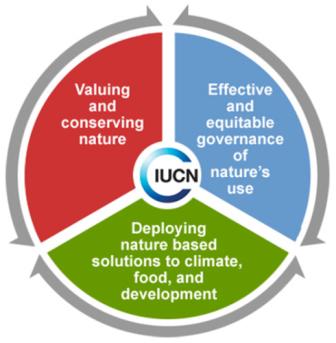
PUMPA - SMART LEARNING
எங்கள் ஆசிரியர்களுடன் 1-ஆன்-1 ஆலோசனை நேரத்தைப் பெறுங்கள். டாப்பர் ஆவதற்கு நாங்கள் பயிற்சி அளிப்போம்
Book Free DemoInternational Union for Conservation of Nature (IUCN) is an international organisation that works in nature conservation and sustainable use of natural resources. IUCN was founded on 5th October 1948 at Gland, Switzerland, to maintain a complete record of all species that lived.
IUCN is a membership union that is composed of government and civil society organisations. It is a global authority on the status of the natural world and safeguarding measures required to protect it.

Logo of IUCN
The vision:
The vision of the IUCN is "A just world that values and conserves nature".
The mission:
The mission of IUCN is to influence, encourage and assist societies all over the world to conserve the integrity and diversity of nature, as well as to ensure that any use of natural resources is fair and ecologically sustainable.

IUCN: Mission
The history:
Throughout its first decade, the IUCN's primary focus was to investigate the impact of human activities on nature. It raised awareness of pesticides' harmful impacts on biodiversity and encouraged environmental impact assessments.
In the 1960s and 1970s, much of IUCN's work focused on protecting species and the habitats that are crucial for their survival. In 1964, IUCN established the IUCN Red List of Threatened Species.
In 1980, IUCN, in collaboration with the UN Environment Programme (UNEP) and the World Wildlife Fund (WWF), published the World Conservation Strategy. It was a groundbreaking document that helped define the concept of "sustainable development" and shaped the global conservation and sustainable development agenda.
About IUCN:
IUCN is best known for compiling and publishing the red list of threatened species that assesses species' conservation status worldwide. IUCN maintains a red data book.
Reference:
https://upload.wikimedia.org/wikipedia/commons/f/fa/IUCN_logo.svg
https://upload.wikimedia.org/wikipedia/commons/2/2a/IUCN_programme_2013-2016.jpg